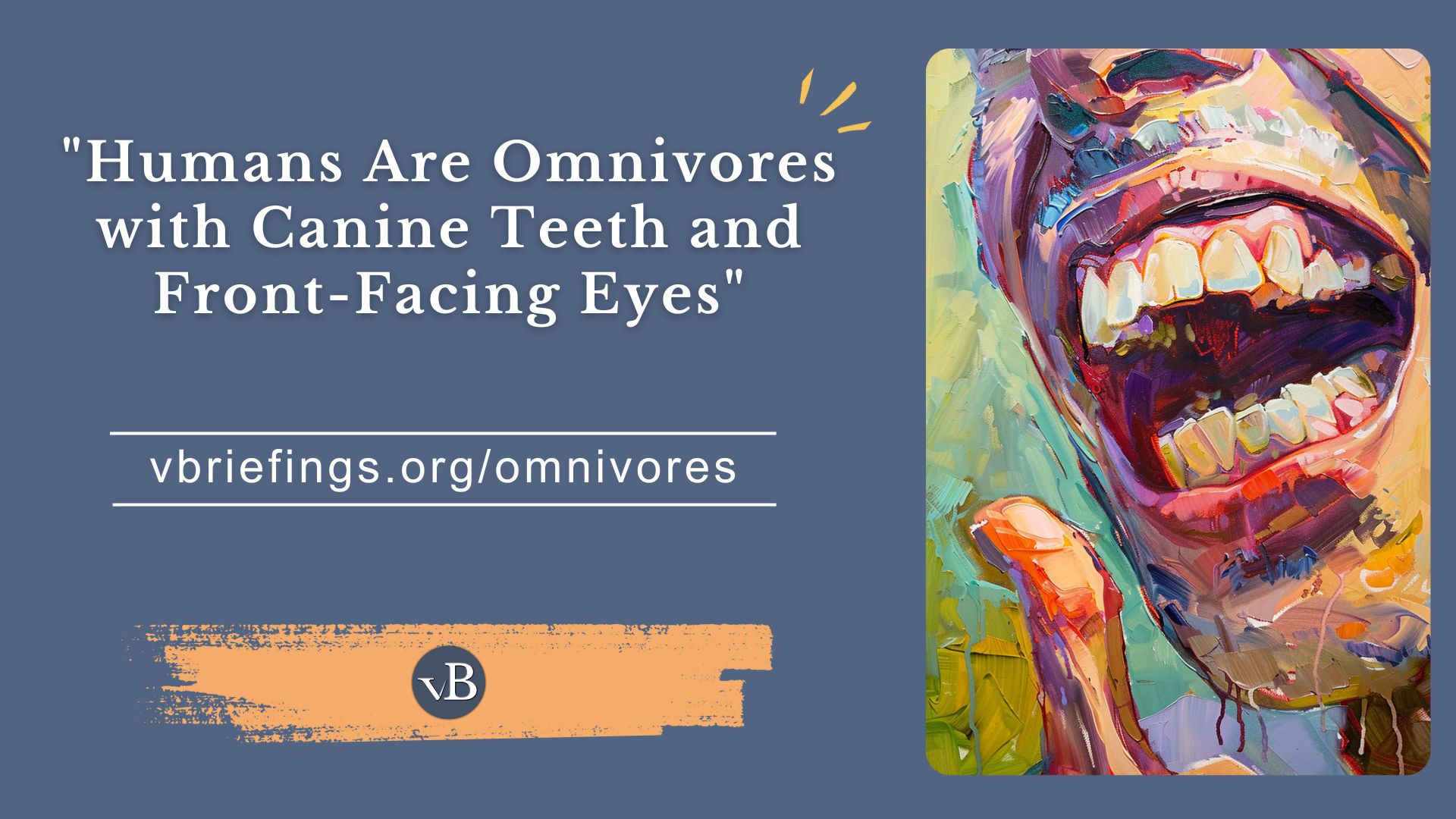Preface
Briefing description and more.
This briefing shows why veganism’s validity isn’t tied to humans being omnivorous, having canine teeth, or front-facing eyes.
Companion Videos
How to use companion videos
Videos may be posted on multiple social media platforms, and you can share them on each platform according each platform’s conventions.
Share this Briefing
Social Media Sharing Image
This image will be used when sharing the briefing on a social media platform. You can see all social sharing images in the grid view.

How to share this briefing
Click on the icon for the platform on which you wish to share. What happens next depends on the platform, but generally a popup will appear, letting you add your own text as you share.
Briefing Meta
Metrics
Note: we will publish additional briefings after completing flashcards and presentation slides for selected briefings.
Counts:
| Main Text | |
| Key Points | 7 |
| Counterclaims | 0 |
| Supplementary | 1 |
| Further Study | 3 |
| Footnotes | 23 |
| Media & Advocacy | |
| Advocacy Notes | 12 |
| —Socratic Questions | 19 |
| Flashcards | 32 |
| Presentation Slides | 0 |
| Memes & Infographics | 0 |
| Companion Videos | 0 |
Other Meta:
Date Posted:
Last Edited:
Edit Log:
Key Points Links
Loading…
Help Us Improve
Please send your suggestions for improvements, or report any issues with this briefing to team@vbriefings.org
We appreciate that you are taking the time to help up improve. All suggestions and reports will be carefully considered.
Summary
A concise summary of the briefing (see below for citations).
The validity of veganism doesn’t rely on humans being natural herbivores or having specific traits. Modern science confirms that plant-based eating is healthy and can mitigate some diseases, rendering arguments about natural diets irrelevant. Canine teeth and front-facing eyes, often cited to justify meat consumption, serve purposes unrelated to carnivorous eating, exposing flaws in the “natural” diet claim.
Context
Places this topic in its larger context.
Humans adapted to consume whatever was available in their environment—whether plants, meat, or other food sources—ensuring survival by taking advantage of the most accessible options at any given time.
While understanding our evolutionary past helps explain what we are capable of eating, it does not dictate what we should eat in the context of health, sustainability, or ethics.
Key Points
This section provides talking points.
The case for veganism does not depend on humans being natural herbivores or having specific physical traits.
A scientific consensus affirms that vegan diets can provide more than sufficient nutrition for human health. So even if humans were natural omnivores and our teeth and eye locations supported that assertion, the science is clear that a strictly herbivorous vegan diet can be not only adequate but also beneficial to our health.
The case for veganism has nothing to do with this issue. Simply put, the case for veganism is that it’s ethically wrong to cause unnecessary harm to animals. Because it’s not necessary to eat animal products for nutrition, any claims that we are natural omnivores are rendered meaningless in this context.
The presence of canine teeth is not an indicator of dietary requirements.
As we discussed earlier, the case for veganism does not depend on humans’ physical traits. Canine teeth are discussed here only because it is a frequently voiced objection to veganism.
Hippopotamuses,1 gorillas,2 camels,3 and saber-toothed deer4 all have sizable canines, and all are herbivorous. Herbivores use canine teeth in various ways. Sizable canines in herbivores are often used for defense.
The relatively short, blunted canines in humans can assist in biting into hard, crunchy plants (such as apples) and ripping vegetable matter, preparing the food for grinding by the other teeth.
One thing seems obvious—human canines are not adequate to kill prey or tear raw flesh for eating.
Science provides evidence that early humans ate mostly plants.
Dr. Colin Barras, a paleontologist and science writer, believes that “archaeologists tend to emphasize the role of meat in ancient human diets, largely because the butchered bones of wild animals are so likely to be preserved at dig sites. Edible plants may have been overlooked simply because their remains don’t survive so well.”5
Rob Dunn declares in Scientific American that “human ancestors were nearly all vegetarians.” In making that assertion, and in questioning the validity of paleo claims, he deems it important to look at the diets of our ancestors at the time our guts were evolving. He states that for primates, a group to which humans belong, plants “were our paleo diet for most of the last thirty million years during which our bodies, and our guts in particular, were evolving. In other words, there is very little evidence that our guts are terribly special and the job of a generalist primate gut is primarily to eat pieces of plants.”6
The notion of a natural diet is problematic.
Even if the concept of a natural diet had made some sense in the context of gatherers and hunters, it would have lost its meaning since the invention of agriculture, which has selectively bred both plant and animal species.
Also, to claim that humans are natural omnivores, one must define what ” natural ” means in this context. If by “natural” you are referring to the ability to obtain nutrients, then humans are omnivores, as we can digest both plants and meat. But, as shown earlier, that still cannot negate the case for veganism.
If you mean it’s natural because it’s nutritionally the best diet for humans, then you are on shaky ground. An increasingly large body of research, as mentioned and cited above, supports the contention that the closer we are to a varied herbivorous diet, the greater our general health and the lower our risk for a multitude of chronic diseases.
Finally, the claim that humans are natural omnivores is an example of the naturalistic fallacy—being natural doesn’t make something ethically or nutritionally sound.
Our inability to kill and eat animals without tools is telling.
Carnivores have the athletic prowess and anatomical features necessary to not only catch and kill their prey but also to tear and rip apart the carcass and process it for eating. Humans lack these features and must use sophisticated tools, such as spears and knives, to accomplish these tasks.
A plant-based diet’s ability to lower the risk of chronic disease suggests that meat is not optimal for health.
Mayo Clinic,7 Harvard Public Health,8 Cleveland Clinic,9 Kaiser Permanente,10 NewYork-Presbyterian,11 and others have all said that a totally plant-based diet is not only sufficient but protective against chronic diseases.
Cleveland Clinic even says that “there really are no disadvantages to a herbivorous diet!”12
The 2025 Academy of Nutrition and Dietetics formal position statement endorses well-planned vegan diets as healthy and nutritionally adequate for adults, and said that “…vegan dietary patterns can be recommended by RDNs [Registered Dietitian Nutritionists], when appropriate, for prevention and management of some chronic diseases…13
- Note: The Academy of Nutrition and Dietetics is the largest global organization of dietetics practitioners, comprising more than 100,000 certified professionals.14
The dietetic associations of other countries, including Canada,15 England,16 and Australia,17 have also made similar pronouncements on the viability of a vegan diet.
Front-facing eyes are not necessarily indicative of predator status.
The claim is made that since many prey animals have eyes on the side of the head and many predator animals have eyes on the front of the head, it follows that humans, who have eyes on the front of the head, are designed to eat copious amounts of meat. The point is made moot, however, not only because the argument for veganism does not depend on physical traits but also because our closest relatives in the animal kingdom, the primates, have eyes in the front of the head.
At least three advantages of frontal eyes for primates have been proposed.
- Binocular vision is crucial for manipulating plant foods. A study titled “Binocularity and brain evolution in primates,” published by the National Academy of Sciences, concludes that “fine-grained stereopsis [binocular vision] is likely to be critical for the visually guided, delicate manipulation of plant foods.”18
- The ability to “see through” foliage is advantageous. The ability to “see through” foliage is advantageous. Theoretical neurobiologist Mark Changizi and Professor of Experimental Psychology Shinsuke Shimojo propose in the Journal of Theoretical Biology the “X-ray vision” hypothesis. According to Changizi and Shimojo, front-facing eyes gave our ancestors the advantage of being able to “see through” the cluttered foliage in the forest. You can see this effect, he states, by placing a finger in front of your eyes and noting that the finger does not block the view of anything behind it.19
- Arboreal locomotion requires accurate depth and distance perception. The depth and distance perception afforded by front-facing eyes was useful to our ancestors when jumping from branch to branch and tree to tree. Edward Collins proposed this idea in 1922 and has subsequently been expanded and refined.20
Counterclaims
Responses to some yes but retorts.
Counterclaims are often not included in objection-type briefings because the objection itself functions as a form of counterargument.
Supplementary Info
Additional information that may prove useful.
Further Study
Sources providing a deeper understanding of the topic or related topics.
Other Resources
“Human Ancestors Were Nearly All Vegetarians” (Scientific American article)22
Advocacy Resources
Information to help with outreach and advocacy.
Note: we will publish additional briefings after completing flashcards and presentation slides for selected briefings.
Share This Briefing
Cloned from the Preface Section on page load.
Companion Videos
Cloned from the Preface Section on page load.
Memes and Infographics
No images found.
How to use Memes and Infographics
To sequence through all memes and infographics on this page, click on any image than use the arrow keys or the arrow buttons to show next and previous images.
To share a meme or infographic, right click on the image and choose download or save as. Then upload the image to the platform of choice.
Presentation Slides
Slides not available.
How to Use the Presentation Slides
You can view the slideshow full screen by clicking on the first link above.
To use Canva presenter mode, view the speaker notes, or download the slides as PowerPoint, login to Canva (the free account works) and follow the Full Canva Link provided above.
To copy this presentation to your own Canva project, use the Full Canva Link provided above, then select File->Make a Copy from the upper left. You can build your own unique presentation from multiple briefings by copying the presentation from each briefing and then building another presentation from the copied presentations.
Flash Cards
We partner with Brainscape because of their excellent features for learning. You will need to create a free Brainscape account to study the cards.
Go to Flash Cards: This will take you to a list of decks.
About Flash Cards and Brainscape
Flash cards are here to help you commit important facts and concepts in this briefing to memory.
In Brainscape, there is one deck for each briefing. You can study more than one deck at a time. Brainscape uses spaced repetition to promote memory retention. It is “the secret to learning more while studying less.”
You can study using your browser, but Brainscape also has a free mobile app that makes learning anywhere easy.
Socratic Questions
Socratic-style questions are embedded in the Advocacy Notes below, and shown in italics.
These are open-ended, thought-provoking questions designed to encourage critical thinking, self-reflection, and deeper understanding. They are inspired by the Socratic method, a teaching technique attributed to the ancient Greek philosopher Socrates, who would ask his students probing questions rather than directly providing answers.
The goal is to help people examine their beliefs, clarify their thoughts, uncover assumptions, and explore the evidence and reasoning behind their ideas.
Advocacy Notes
Tips for Advocacy and Outreach
General Tips
Your goal isn’t to debate human classification but to show that veganism isn’t about what’s “natural”—it’s about what’s ethical and beneficial.
Segue the Conversation Back to Animal Ethics
It’s good to get back to animal ethics as soon as possible.
- “Does a cow that screams in pain while being killed care about our irrelevant justifications?
- “If someone was kicking a dog, would you say, ‘it’s OK, humans are natural omnivores?’” or would you try to stop them? “
- “Even if humans are natural omnivores, how does that justify causing unnecessary suffering when we can choose healthy alternatives?”
Why? This forces them to confront the moral inconsistency of their position.
Challenge the Idea That Being Omnivores Justifies Eating Animals
People often assume that because humans can eat meat, that means we should. But the ability to do something doesn’t make it ethical.
- “What matters isn’t whether we can digest meat—it’s whether eating animals is necessary or ethical. Since we can be healthy without animal products, how does being omnivores justify harming animals?”
- “Humans are omnivores, meaning we can eat both plants and animals. But just because we can do something doesn’t mean it’s right. Would you say that because humans can steal, stealing is justified?”
Why? This shifts the conversation from biology to ethics, making their argument irrelevant to the case for veganism.
Show That Veganism Isn’t About What’s “Natural”
People assume that proving humans are omnivores disproves veganism. But even if we evolved to eat some meat, that doesn’t make it necessary or ethical today.
- “Even if humans evolved to eat some meat in the past, modern science shows that a well-planned vegan diet is perfectly healthy and even reduces disease risk. So why should we base our ethics on outdated survival strategies?”
- “If we only ate what was ‘natural,’ wouldn’t we refuse to take medicine, or cook our food? “
Why? This forces them to reconsider why “natural” should dictate modern choices.
Explain Why Canine Teeth Don’t Prove We’re Meat Eaters
Some people believe that having canine teeth proves we’re designed to eat meat. But many herbivores also have large canines, and human canines are nothing like those of carnivores.
- “Hippos, gorillas, and saber-toothed deer all have huge canines, but they’re herbivores. So having canines doesn’t mean an animal is meant to eat meat.”
- “Our canines are short, blunt, and weak. They help us bite into apples and nuts, not tear raw flesh. If canines made someone a carnivore, would you say a hippo is a meat eater?”
Why? This discredits the idea that canines determine diet.
Explain That Front-Facing Eyes Aren’t Just for Hunting
People argue that humans must be predators because we have forward-facing eyes, like lions and wolves. But many herbivores also have front-facing eyes, and they serve purposes unrelated to hunting.
- “Primates, our closest relatives, have forward-facing eyes, yet they primarily eat plants. If eye placement made someone a predator, wouldn’t gorillas be meat eaters?”
Why? This challenges the assumption that forward-facing eyes = carnivorous diet.
Use Evidence to Show That Early Humans Ate Mostly Plants
Many assume that because our ancestors ate meat, we should too. But evidence suggests that early humans primarily ate plants.
- “Scientific American reports that our ancestors were nearly all vegetarians for most of the last 30 million years while our digestive system was evolving. If evolution determines what we should eat, wouldn’t that mean we should eat mostly plants?”
Why? This corrects the assumption that humans evolved as heavy meat eaters.
Reframe the “Natural Diet” Argument
Even if we knew exactly what diet was “natural” for humans, that wouldn’t determine what’s best today.
- “Calling something ‘natural’ doesn’t make it right. Violence and disease are natural too—should we accept those?”
- “If eating meat was ‘natural,’ why do plant-based diets consistently show better health outcomes and lower rates of chronic disease?”
Why? This forces them to question why they’re relying on a flawed argument.
Point Out That Humans Need Tools to Kill and Eat Animals
Unlike natural carnivores and omnivores, humans cannot hunt, kill, or eat animals without tools.
- “Lions and wolves kill prey with their bodies alone—claws, teeth, speed. If we were natural carnivores, why do we need spears, knives, and fire to eat meat?”
- “If you had to catch and kill an animal with your bare hands and eat it raw, could you? If not, does that sound like something we’re naturally designed to do?”
Why? This highlights how our reliance on tools suggests we’re not natural meat eaters.
Use Science to Show That Plant-Based Diets Are Better for Health
If eating meat were truly optimal for humans, we wouldn’t see so many health benefits from removing it.
- “The Mayo Clinic, Harvard, and Cleveland Clinic all say plant-based diets reduce the risk of heart disease, cancer, and diabetes. If we were designed to eat meat, why does removing it improve health?”
- “The Academy of Nutrition and Dietetics says a well-planned vegan diet is healthy and protective against some chronic diseases. If meat was necessary, wouldn’t they say otherwise?”
Why? This makes them question whether meat is as “natural” as they think.
Appeal to Our Current Situation
Focus on what’s possible today, not what was necessary in the past.
- “If you can be perfectly healthy on a plant-based diet, why justify harming animals just because you can eat meat?”
- “If our ancestors ate meat to survive, but we don’t need it anymore, what’s stopping us from choosing a more ethical and sustainable diet?”
Why? This shifts the conversation away from outdated survival justifications.
Why Not Use Dr. Milton Mills Research?
We choose not to employ a paper frequently referenced in vegan advocacy, Dr. Milton Mills’ “The Comparative Anatomy of Eating.” The paper attempts to show that humans are natural herbivores.
This research has been criticized for oversimplifying human anatomy, exaggerating intestinal length, cherry-picking traits, ignoring key digestive adaptations like stomach acidity, and overlooking the evolutionary flexibility that makes humans natural omnivores. At least some of those criticisms seem valid.
Footnotes
Our sources, with links back to where they are used.
- Ungar, Peter S. Teeth: A Very Short Introduction. OUP Oxford, 27 Mar. 2014. 99. ↩︎
- Pinon, Andrea, and David R Butler. “An Analysis of Gorillas as Zoogeomorphic Agents.” Revista de Geomorfologie, vol. 24, no. 2, 2022, pp. 5–15. Accessed 4 Jan. 2025. ↩︎
- Ungar, Peter S. Teeth: A Very Short Introduction. OUP Oxford, 27 Mar. 2014. 51. ↩︎
- Lars Werdelin. “Hypercanines: Not Just for Sabertooths.” The Anatomical Record, May 30, 2024, https://doi.org/10.1002/ar.25510. Accessed 4 Jan. 2025. ↩︎
- Barras, Colin. “Ancient Leftovers Show the Real Paleo Diet Was a Veggie Feast | New Scientist.” New Scientist, December 5, 2016. ↩︎
- Dunn, Rob. “Human Ancestors Were Nearly All Vegetarians.” Scientific American. July 23 2012. Accessed September 20, 2024. ↩︎
- “Vegetarian Diet: How to Get the Best Nutrition.” Mayo Clinic. Accessed August 2, 2017. ↩︎
- “Becoming a Vegetarian.” Harvard Health Publications Harvard Medical School, March 18, 2016 ↩︎
- Understanding Vegetarianism & Heart Health” Cleveland Clinic, December 2013 ↩︎
- Phillip J Tuso, MD, Mohamed H Ismail, MD, Benjamin P Ha, MD, and Carole Bartolotto, MD, RD. “Nutritional Update for Physicians: Plant-Based Diets.” The Permanente Journal, 2013. ↩︎
- Ask A Nutritionist: Plant-Based Diets.” NewYork-Presbyterian, March 30, 2017 ↩︎
- “Understanding Vegetarianism & Heart Health.” Cleveland Clinic, December 2013. ↩︎
- Raj, Sudha, et al. “Vegetarian Dietary Patterns for Adults: A Position of the Academy of Nutrition and Dietetics.” PDF. Journal of the Academy of Nutrition and Dietetics, 7 Feb. 2025. ↩︎
- Join Academy of Nutrition & Dietetics | Indiana Academy of Nutrition & Dietetics.” Indiana Academy of Nutrition & Dietetics |, 17 Aug. 2020. Accessed 23 Feb. 2025. ↩︎
- “Healthy Eating Guidelines for Vegans.” Dietitians of Canada, November 2017. ↩︎
- “British Dietetic Association.” The Vegan Society. Accessed August 3, 2017. ↩︎
- Dietitians Australia. “What Is a Vegetarian Diet?” Dietitians Australia, 2022, Accessed 4 Jan. 2025. ↩︎
- Barton, R. A. “Binocularity and Brain Evolution in Primates.” Proceedings of the National Academy of Sciences of the United States of America 101, no. 27 (July 6, 2004). ↩︎
- Changizi, Mark A., and Shinsuke Shimojo. “‘X-Ray Vision’ and the Evolution of Forward-Facing Eyes.” Journal of Theoretical Biology 254, no. 4 (October 21, 2008): 756–67. ↩︎
- Goldman, Jason G. “Evolution: Why Do Your Eyes Face Forwards?” BBC, October 28, 2014. ↩︎
- Shelley, Percy Bysshe. A Vindication of Natural Diet. Percy Bysshe Shelley. Kindle e-Book, A public domain book. Vegetarian Society, 1843. ↩︎
- Dunn, Rob. “Human Ancestors Were Nearly All Vegetarians.” Scientific American, July 23, 2012. Accessed September 20, 2024. ↩︎




